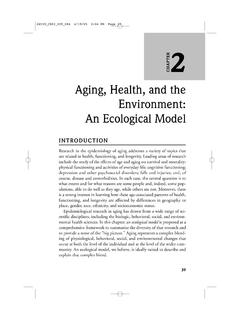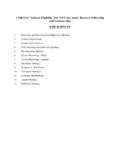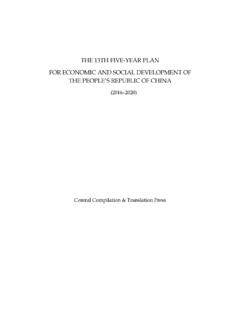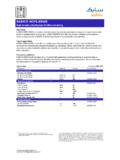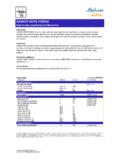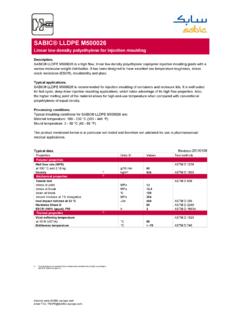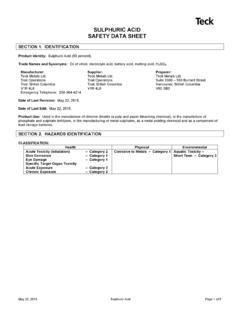Transcription of CYTEC MATERIAL SAFETY DATA - Canadian Zinc …
1 CYTEC MATERIAL SAFETY DATA. Page 1 of 6. MSDS No: 00293. Date: 07/31/2000. 1. CHEMICAL PRODUCT AND COMPANY IDENTIFICATION. PRODUCT NAME: AERO 343 xanthate SYNONYMS: Sodium isopropyl xanthate CHEMICAL FAMILY: xanthate MOLECULAR FORMULA: C4H8OS2Na MOLECULAR WGT: CYTEC INDUSTRIES INC., FIVE GARRET MOUNTAIN PLAZA, WEST PATERSON, NEW JERSEY 07424, USA. For Product Information call 1-800/652-6013. Outside the USA and Canada call 1-973/357-3193. EMERGENCY PHONE: For emergency involving spill, leak, fire, exposure or accident call CHEMTREC: 1- 800/424-9300. Outside the USA and Canada call 1-703/527-3887. 2. COMPOSITION/INFORMATION ON INGREDIENTS. OSHA REGULATED COMPONENTS. COMPONENT CAS. NO. %T WA/CEILING REFERENCE. Carbonodithioic 000140-93-2 87-89 not established acid, O-Isopropyl ester, sodium salt Sodium hydroxide 001310-73-2 0-1 2 mg/m3 OSHA. 2 mg/m3 ceiling ACGIH. Sodium sulfide 001313-82-2 0-1 not established Isopropanol 000067-63-0 0-1 400 ppm OSHA/ACGIH.
2 500 ppm STEL ACGIH. 3. HAZARDS IDENTIFICATION. EMERGENCY OVERVIEW. APPEARANCE AND ODOR: Pellets or powder, pale yellow to green, slight disagreeable odor. STATEMENTS OF HAZARD: WARNING! SELF-HEATING MATERIAL . MAY BE SPONTANEOUSLY COMBUSTIBLE. MAY FORM EXPLOSIVE DUST - AIR MIXTURES. DUST IRRITATING. CAUSES EYE IRRITATION. MAY CAUSE ALLERGIC SKIN REACTION. POTENTIAL HEALTH EFFECTS. EFFECTS OF OVEREXPOSURE: The acute oral (rat) LD50 and acute dermal (rabbit) LD50 value for this MATERIAL are estimated to be >800. mg/kg and >1000 mg/kg, respectively. Airborne dust may cause significant eye, skin or respiratory tract irritation. Skin or eye contact with solutions of this product may cause moderate eye and skin irritation. Repeated or prolonged dermal contact with this MATERIAL may cause allergic skin reactions. Refer to Section 11 for toxicology information on the OSHA regulated components of this product.
3 AERO _ 343 xanthate MSDS No: 00293 Date: 07/31/2000 Page 2 of 6. 4. FIRST AID MEASURES. If swallowed, call a physician immediately. ONLY induce vomiting at the instructions of a physician. Never give anything by mouth to an unconscious person. In case of skin contact, immediately wash affected areas with soap and plenty of water. Remove contaminated clothing and shoes. Obtain medical attention. Destroy or thoroughly clean shoes before reuse. Do not reuse contaminated clothing without laundering. In case of eye contact, immediately irrigate with plenty of water for 15 minutes. Obtain medical attention if irritation persists or if otherwise necessary. If vapor or dust of this MATERIAL is inhaled, remove from exposure. Administer oxygen if there is difficulty in breathing. Obtain medical attention immediately if necessary. 5. FIRE FIGHTING MEASURES. FLAMMABLE PROPERTIES. FLASH POINT: Not applicable FLAMMABLE LIMITS (% BY VOL): Not applicable AUTOIGNITION TEMP: Not available DECOMPOSITION TEMP: >428 F; 220C.
4 EXTINGUISHING MEDIA AND FIRE FIGHTING INSTRUCTIONS. Use carbon dioxide, dry chemical or large quantities of water to extinguish fires. Heat causes decomposition to vapor of carbon disulfide. Wear self-contained, positive pressure breathing apparatus and full firefighting protective clothing. Solid xanthates are stable when kept cool and dry. However, exposure to heat and moisture can cause decomposition to flammable and explosive vapor of carbon disulfide. Since xanthates decompose in solution, even at room temperature, fire and explosion hazards can develop with aging. The moisture precautions do not apply to the product when diluted according to the CYTEC Product Bulletin. 6. ACCIDENTAL RELEASE MEASURES. STEPS TO BE TAKEN IN CASE MATERIAL IS RELEASED OR SPILLED. Where exposure level is not known, wear NIOSH approved, positive pressure, self-contained respirator. Where exposure level is known, wear NIOSH approved respirator suitable for level of exposure.
5 Wear same protective clothing/equipment as in Section 8 (Exposure Controls/Personal Protection). Sweep up spills and place in a waste disposal container. Flush area with water. 7. HANDLING AND STORAGE. Avoid excessive heat or moisture. May contain finely divided MATERIAL . Dust suspended in air may ignite with static discharge, sparks or flame. Equipment, including venting systems, should be grounded. Provide adequate ventilation in areas of use to remove dust. Avoid breathing dust. Keep container closed. Use non- sparking tools and do not smoke when opening drum. Avoid contact with eyes. Avoid prolonged or repeated contact with skin. Wash thoroughly after handling. Heating or overexposure to moisture of solid xanthates or heating or aging of xanthate solutions causes some decomposition to poisonous and flammable carbon disulfide. Maintain good housekeeping to control dust accumulations. Special precautions against fire and explosion must be observed in (1) pumping xanthate solutions, (2) draining mobile tanks, (3) cleaning mobile tanks, and (4) performing maintenance work on storage tanks and pipelines leading to and from tanks.
6 Storage tanks should have certain design features for maximum SAFETY , and the vapor space should be free of sources of ignition. Use nonsparking tools and do not smoke when opening drums of xanthate . Do not use xanthate products until you have read the " SAFETY Discussion" in the AERO xanthate Handbook from this Company. AERO 343 xanthate MSDS No: 00293 Date: 07/31/2000 Page 3 of 6. DUST EXPLOSION HAZARD CLASS -1 Handling of MATERIAL should be in accordance with NFPA-68. If handled with flammable or combustible materials the explosion hazard may increase. 8. EXPOSURE CONTROLS/PERSONAL PROTECTION. ENGINEERING CONTROLS AND PERSONAL PROTECTIVE EQUIPMENT (PPE). Where this MATERIAL is not used in a closed system, good enclosure and local exhaust ventilation should be provided to control exposure. Food, beverages, and tobacco products should not be carried, stored, or consumed where this MATERIAL is in use.
7 Before eating, drinking, or smoking, wash face and hands with soap and water. Avoid skin contact. Protective clothing such as impervious gloves, apron, workpants, long sleeve work shirt, or disposable coveralls are recommended to prevent skin contact. For operations where eye or face contact can occur, wear eye protection such as chemical splash proof goggles or face shield. Eyewash equipment and SAFETY shower should be provided in areas of potential exposure. Where exposures are below the Permissible Exposure Limit (PEL), no respiratory protection is required. Where exposures exceed the PEL, use respirator approved by NIOSH for the MATERIAL and level of exposure. See "GUIDE TO. INDUSTRIAL RESPIRATORY PROTECTION" (NIOSH). 9. PHYSICAL AND CHEMICAL PROPERTIES. APPEARANCE AND ODOR: Pellets or powder, pale yellow to green, slight disagreeable odor. BOILING POINT: Not applicable MELTING POINT: Not available VAPOR PRESSURE: Not applicable SPECIFIC GRAVITY: @ 20 C.
8 VAPOR DENSITY: Not applicable % VOLATILE (BY WT): Not available pH: Not applicable SATURATION IN AIR (% BY VOL): Not applicable EVAPORATION RATE: Negligible SOLUBILITY IN WATER: 37 g/100 g @ 20 C. VOLATILE ORGANIC CONTENT: Not available 10. STABILITY AND REACTIVITY. STABILITY: Stable CONDITIONS TO AVOID: See Section 7 (Handling and Storage). POLYMERIZATION: Will Not Occur CONDITIONS TO AVOID: None known INCOMPATIBLE MATERIALS: Strong oxidizing agents, acidic MATERIAL and high temperatures. HAZARDOUS DECOMPOSITION PRODUCTS: carbon disulfide; carbon monoxide; carbon dioxide; oxides of sulfur (includes sulfur di and tri oxides). 11. TOXICOLOGICAL INFORMATION. Toxicological information for the product is found under Section 3. HAZARDS IDENTIFICATION. Toxicological information on the OSHA regulated components of this product is as follows: Sodium isopropyl xanthate has an acute oral (rat) and acute dermal (rabbit) LD50 values of >800 mg/kg and >1,000 mg/kg, respectively.
9 Direct contact with this MATERIAL may cause irritation to skin, eyes, mucous membrane and respiratory tract. It has been reported direct contact may cause moderate skin sensitation. Sodium isopropyl xanthate tested negative for Ames test. AERO 343 xanthate MSDS No: 00293 Date: 07/31/2000 Page 4 of 6. Acute overexposure to sodium hydroxide mists or dusts causes severe respiratory irritation. A solution of sodium hydroxide can produce irreversible damage to eyes and skin. Sodium sulfide has an acute oral (rat) LD50 value of 208 mg/kg. Sodium sulfide severely irritates the skin and eyes, as well as, mucous membranes. This MATERIAL liberates hydrogen sulfide upon contact with acids. Isopropanol has acute oral (rat) and dermal (rabbit) LD50 values of g/kg and g/kg, respectively. The 4-hour inhalation LC50 (rat) for isopropanol is >16,000 ppm ( mg/L). Acute overexposure to isopropanol vapor may cause mild irritation of the eyes and respiratory tract.
10 Chronic overexposure to isopropanol vapors may cause central nervous system depression, headaches, dizziness, nausea, and staggered gait. Liquid isopropanol is a severe eye irritant. 12. ECOLOGICAL INFORMATION. This MATERIAL is not readily biodegradable. LC50. TROUT 96 HOUR: 595 mg/L. BOD. 28 Day: %. OCTANOL/H2O PARTITION COEF.: Not applicable 13. DISPOSAL CONSIDERATIONS. The information on RCRA waste classification and disposal methodology provided below applies only to the CYTEC product, as supplied. If the MATERIAL has been altered or contaminated, or it has exceeded its recommended shelf life, the guidance may be inapplicable. Hazardous waste classification under federal regulations (40 CFR Part 261 et seq) is dependent upon whether a MATERIAL is a RCRA "listed hazardous waste" or has any of the four RCRA "hazardous waste characteristics." Refer to 40 CFR Part to determine if a given MATERIAL to be disposed of is a RCRA "listed hazardous waste"; information contained in Section 15 of this MSDS is not intended to indicate if the product is a "listed hazardous waste.


